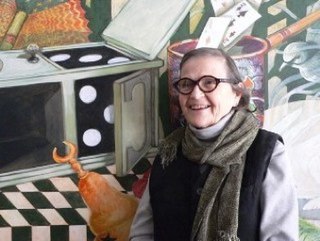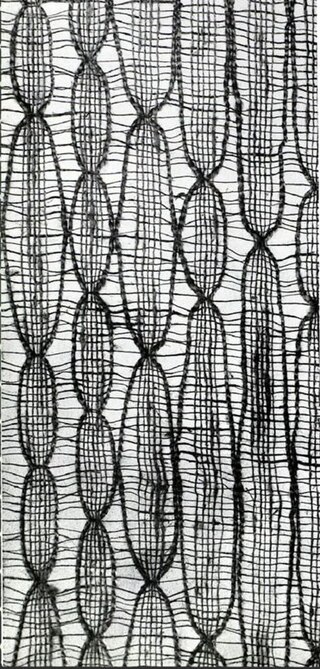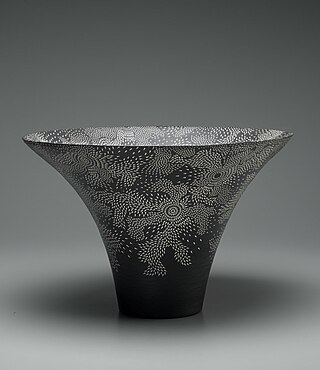
Anne Truitt, born Anne Dean, was an American sculptor of the mid-20th century.

Mariko Mori is a Japanese multidisciplinary artist. She is known for her photographs and videos of her hybridized future self, often presented in various guises and featuring traditional Japanese motifs. Her work often explores themes of technology, spirituality and transcendence.

Nancy Graves was an American sculptor, painter, printmaker, and sometime filmmaker known for her focus on natural phenomena like camels or maps of the Moon. Her works are included in many public collections, including those of the National Gallery of Art, the Brooklyn Museum of Art, the Smithsonian American Art Museum, the National Gallery of Australia (Canberra), the Des Moines Art Center, Walker Art Center (Minneapolis), and the Museum of Fine Arts. When Graves was just 29, she was given a solo exhibition at the Whitney Museum of American Art. At the time she was the youngest artist, and fifth woman to achieve this honor.
Tara Donovan is an American sculptor who lives and works in Brooklyn, New York. Her large-scale installations, sculptures, drawings, and prints utilize everyday objects to explore the transformative effects of accumulation and aggregation. Known for her commitment to process, she has earned acclaim for her ability to exploit the inherent physical characteristics of an object in order to transform it into works that generate unique perceptual phenomena and atmospheric effects. Her work has been conceptually linked to an art historical lineage that includes Postminimalism and Process artists such as Eva Hesse, Jackie Winsor, Richard Serra, and Robert Morris, along with Light and Space artists such as Mary Corse, Helen Pashgian, Robert Irwin, and James Turrell.
Mary Frank is a British and American visual artist who works as a sculptor, painter, printmaker, draftswoman, and illustrator.

The feminist art movement in the United States began in the early 1970s and sought to promote the study, creation, understanding and promotion of women's art. First-generation feminist artists include Judy Chicago, Miriam Schapiro, Suzanne Lacy, Judith Bernstein, Sheila de Bretteville, Mary Beth Edelson, Carolee Schneeman, Rachel Rosenthal, and many other women. They were part of the Feminist art movement in the United States in the early 1970s to develop feminist writing and art. The movement spread quickly through museum protests in both New York and Los Angeles, via an early network called W.E.B. that disseminated news of feminist art activities from 1971 to 1973 in a nationally circulated newsletter, and at conferences such as the West Coast Women's Artists Conference held at California Institute of the Arts and the Conference of Women in the Visual Arts, at the Corcoran School of Art in Washington, D.C..

Beatriz Milhazes is a Brazilian artist. She is known for her work juxtaposing Brazilian cultural imagery and references to western Modernist painting. Milhazes is a Brazilian-born collage artist and painter known for her large-scale works and vibrant colors. She has been called "Brazil's most successful contemporary painter."
Leila Daw is an American installation artist and art professor; her work uses diverse materials to explore themes of cartography and feminism.
Ellen Gallagher is an American artist. Her work has been shown in numerous solo and group exhibitions and is held in the permanent collections of many major museums. Her media include painting, works on paper, film and video. Some of her pieces refer to issues of race, and may combine formality with racial stereotypes and depict "ordering principles" society imposes.

Ellen Lanyon was a painter and printmaker from Chicago, Illinois. She received her BFA from the School of the Art Institute of Chicago (SAIC), her MFA from the University of Iowa School of Art and Art History and studied restoration at the Courtauld Institute of Art. She also received an honorary doctorate from SAIC. Her works are in the permanent collections of many major American museums, including the Art Institute of Chicago, the Museum of Contemporary Art Chicago, the Metropolitan Museum of Art, the Smithsonian American Art Museum, and the Ulrich Museum.

Lisa Gralnick is an American contemporary metalsmith, studio jeweler and academic. She works in the field of craft and art jewelry. Gralnick says: "I have chosen to make jewelry, which is traditionally considered 'craft', and I do enjoy the processes and techniques that allow me to execute my work without technical faults. But 'craft' is only a means to an end for me, as it is for many artists. My desire to push the limits of jewelry and expand on them, to comment on its traditions and associations, is more the concern of any artist."

Kay Sekimachi is an American fiber artist and weaver, best known for her three-dimensional woven monofilament hangings as well as her intricate baskets and bowls.

Rebecca Kamen is an American artist. Kamen's artwork is influenced and inspired by scientific work in many areas, from medieval alchemical manuscripts to the periodic table, to theories of black holes. Informed by science, her works attempt to illuminate its hidden beauty.

Jennie C. Jones is an African-American artist living and working in Brooklyn, New York. Her work has been described, by Ken Johnson, as evoking minimalism, and paying tribute to the cross-pollination of different genres of music, especially jazz. As an artist, she connects most of her work between art and sound. Such connections are made with multiple mediums, from paintings to sculptures and paper to audio collages. In 2012, Jones was the recipient of the Joyce Alexander Wien Prize, one of the biggest awards given to an individual artist in the United States. The prize honors one African-American artist who has proven their commitment to innovation and creativity, with an award of 50,000 dollars. In December 2015 a 10-year survey of Jones's work, titled Compilation, opened at the Contemporary Arts Museum in Houston, Texas.

Kitamura Junko is a Japanese ceramic artist. Examples of her work are in the Museum of Fine Arts, Houston, The Brooklyn Museum, the British Museum, the Museum of Fine Art, Boston, and the Arthur M. Sackler Gallery, Smithsonian. She has won prizes for her work from the Siga Prefecture Art Exhibition in 1983, the Kyoto Art and Crafts Exhibition in 1984 and 1985, and the World Triennial Exhibition of Small Ceramics in Zagreb, Croatia in 1997. Kitamura completed her MFA at the Kyoto City University of Art. She is married to artist Yo Akiyama, and was the student of two prominent Japanese artists: Suzuki Osamu and Kondo Yutaka.

Nalini Malani is an Indian artist, among the country's first generation of video artists.

The Fresno Art Museum is an art museum in Fresno, California. The museum's collection includes contemporary art, modern art, Mexican and Mexican-American art, and Pre-Columbian sculpture.

Gina Beavers is an American artist based in the New York area. She first gained attention in the early 2010s for thickly painted, relief-like acrylic images of food, cosmetics techniques and bodybuilders appropriated from Instagram snapshots and selfies found using hashtags such as #foodporn, #sixpack and #makeuptutorial. Her later work has continued to recombine these recurrent subjects, as well as explore memes, irreverent conflations of genres or art history and kitsch, identity, fandom and celebrity-worship. In 2019, New York Times critic Martha Schwendener described her paintings as "canny statements on contemporary bodies, beauty and culture … [that] tackle the weirdness of immaterial images floating through the ether, building them up into something monumental, rather than dismissing them."
Nancy Genn is an American artist living and working in Berkeley, California known for works in a variety of media, including paintings, bronze sculpture, printmaking, and handmade paper rooted in the Japanese washi paper making tradition. Her work explores geometric abstraction, non-objective form, and calligraphic mark making, and features light, landscape, water, and architecture motifs. She is influenced by her extensive travels, and Asian craft, aesthetics and spiritual traditions.

Jill O'Bryan is an American contemporary artist whose work draws upon breath, bodily movement and the natural environment in order to examine the experience of being, time and place. She is most known for her "Breath Drawings," in which she records each of her breaths with an individual mark thousands of times, and her ground rubbings (frottages), which document her physical engagement with the New Mexico desert mesa. Southwest Contemporary wrote, "O’Bryan’s artmaking is not an act of representational picture-making but a practice of accumulating the residue of recorded time and place through the physical actions of her body. Her process is performative, specifically located in time and space, and records moment-to-moment interactions with the elements."















